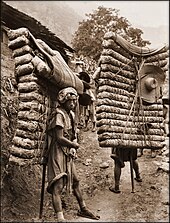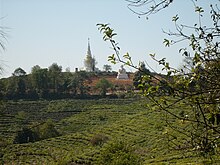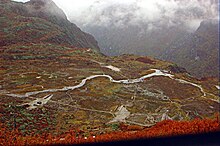Tea Horse Road
The Tea Horse Road ( Chinese 茶 馬 道 / 茶 马 道 , Pinyin Chámǎdào , also: 茶 馬 古道 / 茶 马 古道 , Chámǎgǔdào - "Old Tea Horse Road") was a trade route between the Chinese provinces of Yunnan ( 雲南 / 云南 ) and Sichuan ( 四川 ) in the east and Tibet and India in the west. Sometimes it is also called the Southern Silk Road . Of the numerous tea routes that led from the tea-growing areas in these two provinces in all directions, she had to overcome the greatest scenic obstacles. She crossed several mountain ridges of up to more than 4000 meters and several large rivers. She was interrupted eight months a year because of snowy passes.
Were
The most important goods were tea from China , of which the greater part went to Tibet and the smaller part to India, and horses from Tibet, which were mainly used in China for the army (in the south of the empire). The tea trade is explained by the fact that before 1830 there was no tea cultivation in India. Tibet also sourced salt from China. Silk from China and opium were also transported to China.
Routes
Strictly speaking, the Tee Horse Road consisted to a large extent of mule tracks and had several variants. Horses were brought along these trails as goods, but mules served as pack animals, as in many other mountain regions . Quite a few caravans consisted of porters .
The northern routes, from Chengdu in Sichuan to the west and from Dali ( 大理 ) in Yunnan to the northwest, united in Markam County ( Tibetan སྨར་ ཁམས ; Chinese 芒康 , Pinyin Mángkāng ) in eastern Tibet in Chengguan ( ཆབ་ མདོ་ ) on the upper reaches of the Mekong and led from there south of the upper reaches of the Saluen to Lhasa ( ལྷ་ ས་ ). From there it went over Gyangzê ( རྒྱལ་ རྩེ) and the pass Nathu La ( རྣ་ ཐོས་ ལ་ ) through Sikkim to Calcutta in Bengal . From Chengdu or Dali it was about 2000 km to Lhasa, about 3000 km to Calcutta, and a few hundred kilometers more from the main tea-growing areas in the south and east of Yunnan.

The southern routes to India, which from Dali through the north of Myanmar , reached Nagaland and the Brahmaputra - Ganges delta, reached Calcutta, were less used . Although they were shorter and passed lower altitudes than the northern, but more borders and the areas of uncontrolled hill tribe. And Tibet was off these routes. Since Tibet was the horse exporter, they are not part of the Tea Horse Road.
Northern and southern routes avoided the particularly impassable Hengduan Shan ( 橫斷 山 / 横断 山 ) mountains .
history

In the 7th / 8th In the 19th century, the Tibetans got a taste for so-called brick tea from Yunnan. Horses were offered as barter goods, as these were extremely rare in parts of southern China. A war horse had the equivalent of 20 to 60 kg of tea. In the Tang Dynasty (618–907), trade between Tibet and Yunnan gained momentum.
It had its heyday in the Song era , when checkpoints numbered up to 2,000 traders a day and some 7,500 tons of tea were brought to Lhasa per year.
Under the Mongol rule ( Yuan dynasty , 1279–1368), trade collapsed somewhat. Under the Ming emperors (1368–1644) he recovered, but was increasingly regulated.
The Manchu rulers ( Qing Dynasty ) finally banned the import of horses in 1735. And when tea production started in India after 1840, the country south of the Himalayas was lost as a market for Chinese tea, but Tibet was not. With the construction of highways in Tibet in the 1960s, caravan traffic ended.
Individual evidence
- ^ Silkroad Foundation, Adela CY Lee: The "Ancient Tea and Horse Caravan Road," the "Silk Road" of Southwest China. In: silkroadfoundation.org. Retrieved November 3, 2018 .
- ↑ THE TEA-HORSE TRADE ROUTE. In: the-wanderling.com. Retrieved November 3, 2018 .



